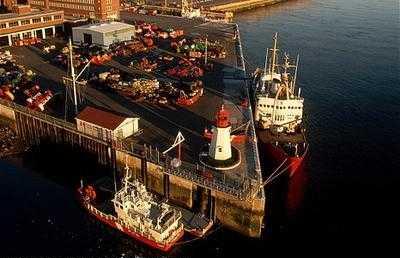
The chief doorways of the world of international commerce are its harbours and ports. Through them pass cargoes and travellers from one part of the globe to another. A harbour is any sheltered body of water where boats or ships may moor or anchor. A port is an installation that has been built around a harbour with facilities for loading and unloading such vessels.

Ordinarily a harbour, either natural or man-made, must exist before a port facility can be set up. Some large harbours--San Francisco Bay on the California coast, for example--are used by several ports. Some ports, such as Chicago, Ill., on Lake Michigan, are served by several small harbours.
The major requirements of a good harbour are direct access to the open water and sufficient depth for vessels to enter and exit safely. Ocean harbours are commonly 40 feet deep or more. The harbour should be well protected against storms and large waves. The bottom of the harbour should provide good holding ground for anchors--it must not be too rocky, too sandy, or too muddy. The harbour should also be spacious enough for ships to ride at anchor and to manoeuvre. Currents and tides must not be excessive.
Harbours are classified according to their location and structure. A natural coastal harbour is formed by a bay (New York City, for example) or by an offshore barrier such as an island (Hong Kong, China). A coastal breakwater harbour (Casablanca, Morocco) is sheltered by one or more man-made breakwaters. A tide gate harbour has locks that enclose areas of the harbour at high tide. As water leaves the harbour with low tide, the water level in the locked-off areas remains constant. At the port of Liverpool, England, tide gates are a necessity, for the tidal range of its harbour is approximately 21 feet.
A natural river harbour (New Orleans, La.) is sheltered from storms by virtue of the narrowness of the river. A river basin harbour (Rotterdam, The Netherlands) has slips dug into the riverbanks to accommodate vessels. A lake harbour or canal harbour (Bruges, Belgium) is on a small lake or an artificial canal that is connected with the open water by means of a navigable waterway. An open roadstead harbour offers little protection from storms, though it may serve as a port. Many harbours of this type are found along the coasts of Africa.
Breakwaters are massive, wall-like structures that partially enclose a harbour, protecting it from waves and currents. They may provide a harbour's total shelter or supplement protection present in the natural state. Breakwaters are made of stone, concrete, or rubble. Jetties, less substantial than breakwaters, are found within a harbour and are used to contain currents or to control the deposit of sediment. They are often made of timber, steel sheeting, or concrete.
Harbour channels are marked with buoys. These are floating objects moored to the bottom. The anchorage is that part of a harbour in which ships lie at anchor. Many narrow harbours, particularly those on rivers, have turning basins in which ships are turned around.